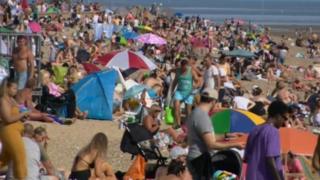
As the world races to find treatments and vaccines for coronavirus, scientists have another target in their sights – the superspreading event, when one person infects many others.
And there is a new number that’s key to understanding why that happens.
What is the k number?
During the pandemic, there has been a focus on the reproduction or R number. This is the number of people that one infected person will pass on the virus to, on average.
However, not every person with coronavirus passes it on to the same number of people. Some may self-isolate and infect nobody, while others go about their life and infect many people.
This is where the k number is useful. It measures the difference in how many people each person with coronavirus infects.
The smaller the k number is, the lower the number of people who are transmitting the disease to others is. This means more superspreaders, each individually infecting higher numbers of people.
About 10-15% of people are responsible for about 80% of infections, according to an expert.
Dr Adam Kucharski, of the London School of Hygiene and Tropical Medicine (LSHTM), says: “Typically, what happens is a lot of people don’t give the infection to anyone.
“And then there’s a handful of events where you see large amounts of transmission happening with five, 10, 20 people potentially infected. And we saw that even quite early on with Covid.”
Why does superspreading happen?
Covid-19 is passed on through people shedding virus particles from their bodies.
How infectious someone is depends on many factors that differ dramatically from person to person, including:
- the dose of virus in their original infection
- how long they have been infected for
- the severity of their symptoms
But it is what they do when they are at their most infectious that really drives superspreading events.
“If someone, when they’re most transmissible, happens to go to an all-day meeting with a large number of people, and then go out for dinner afterwards, you may well see a superspreading event,” Dr Kucharski says.
“If that person happened to have an evening at home, it might not have generated any transmission.”
Where is superspreading happening?
Scientists have been keeping track of clusters of Covid-19 since the pandemic began.
Dr Gwen Knight, from LSHTM, says: “We found that many of the settings are what we expected.
“So care settings – hospitals and care homes – unfortunately, are coming up.
“And also cruise ships, which is something we know from other infectious diseases.”
But she also found clusters repeatedly appearing in other places – meat-processing plants, choirs, bars and gyms.
All of these involve being indoors, in close contact with others, for prolonged periods of time.
But Dr Knight says there is another common thread.
“These settings are likely to be loud settings, and obviously, that has an impact on the kind of breathing you do,” she says.
“There is the hypothesis that because it’s loud, and you’re expelling more or faster air, it could be this that makes the setting more and more risky.
“There were several clusters linked to fitness classes in South Korea, and more were linked to Zumba classes than to pilates classes.
“So it might be that you’re engaged in an exercise that requires you to breathe more heavily and deeper, as opposed to a more gentle breathing, for example.”
Can superspreading happen outside?
Dr Muge Cevik, of the University of St Andrews, says: “Not all activities, not all environments have the same risk of infection.
“So, for example, the risk of infection would be higher indoors compared to outdoors.
“Outdoors, generally people worry about cyclists or runners passing by – but that would be lower risk. We could say the transmission risk is negligible.
“Whereas if you spend a whole day together, in a big group in a park, and if you exchange lots of food and you have really close contact, less than 2m (6ft), the risk is lower than being indoors – but there is still risk.”
Hand-washing, social distancing and not sharing utensils is essential, she says.
How can understanding superspreading help?
Strict lockdowns were a blunt tool for halting the spread of coronavirus.
But as infections decrease, and the world opens up, scientists say a more targeted approach is needed,
Dr Cevik says: “We need to understand the transmission dynamics so we can concentrate our contact-tracing focus.
“But if we can avoid these superspreading events, and the environments and activities associated with them, you can decrease almost 80% of infections.
“And that’s huge.”
Follow Rebecca on Twitter
Source: BBC News – Health










